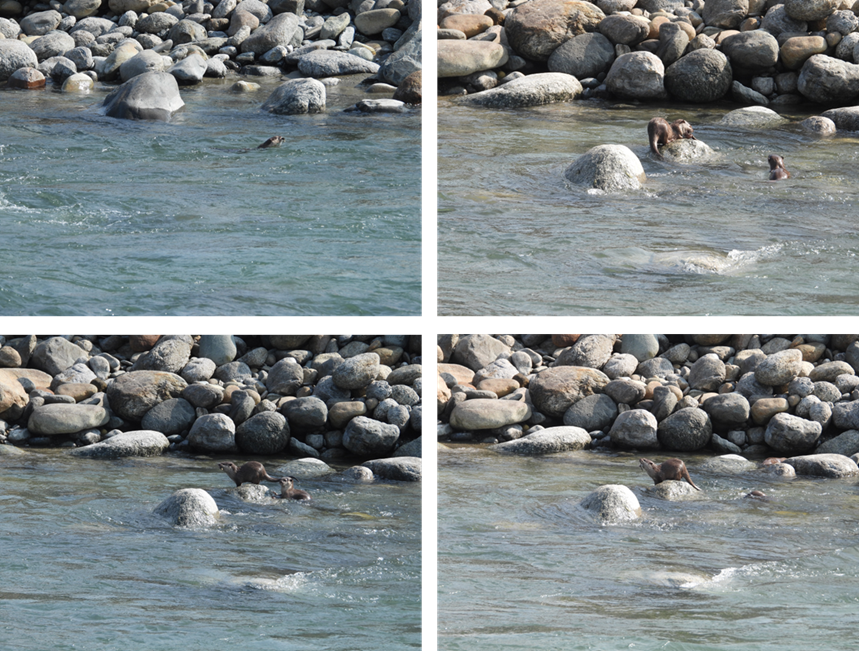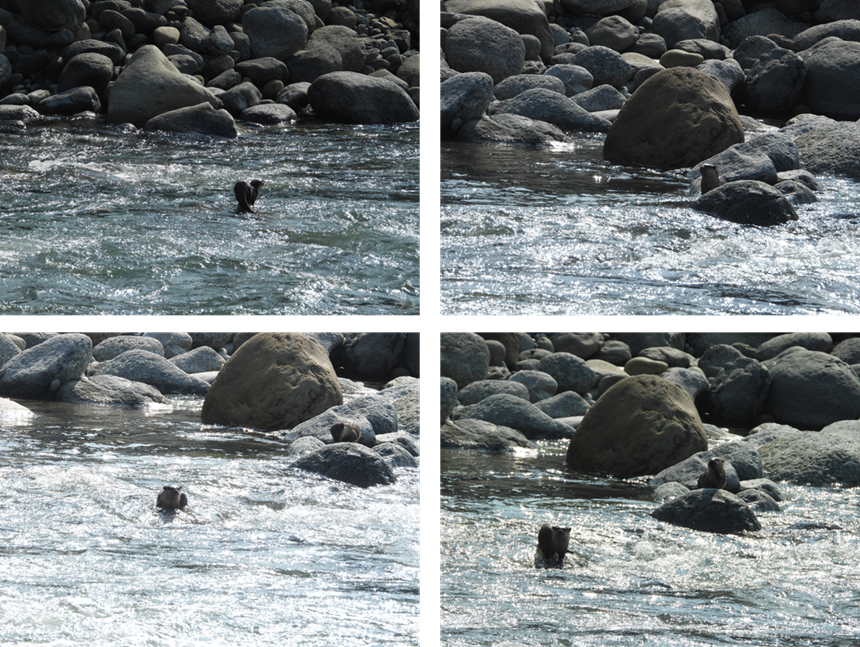IUCN/SSC Otter Specialist Group Bulletin

©IUCN/SCC Otter Specialist Group
Volume 40 Issue 4 (October 2023)
Citation: Menzies, R.K. (2023). An Update on Asian Small-Clawed Otters (Aonyx cinereus) From Namdapha Tiger Reserve, Arunachal Pradesh, India. IUCN Otter Spec. Group Bull. 40 (4): 225 - 229
An Update on Asian Small-Clawed Otters (Aonyx cinereus) From Namdapha Tiger Reserve, Arunachal Pradesh, India.
1Nature Conservation Foundation, 1311, “Amritha”, 12th Main, Vijayanagar 1st Stage, Mysore 570017, Karnataka, India
2Manipal Academy of Higher Education, Manipal 576104, Karnataka, India
Email: rohanmenzies@ncf-india.org
Received 21st July 2023, accepted 22nd July 2023
Abstract: The Asian Small-clawed Otter (Aonyx cinereus) is widespread across Southeast Asia but is experiencing a steady decline in numbers and a reduction in its range. This species is often not studied or even recorded from northeast India and therefore very little is known about it. This note builds on a recent publication on the feeding behaviour of Asian Small-clawed Otters from Namdapha Tiger Reserve in India.
Keywords: Aonyx cinereus, Asian Small-clawed Otter, Arunachal Pradesh, feeding behaviour, India
Bida (2023) described two sightings of the Asian Small-clawed Otter (Aonyx cinereus) from two different locations in the Namdapha Tiger Reserve from March 2020 and March 2021, respectively, which included details on foraging and prey species. From this protected area, where otters appear to be the only small carnivores specifically targeted by hunters (Naniwadekar et al., 2013), descriptions of otters could help inform conservation not simply by their occurrences but also by better understanding their ecology. Here, I briefly report an encounter with Asian Small-clawed Otters which corroborate the note by Bida (2023) along with additional observations on their foraging strategies.
On 23 February 2023 at approximately 0900h, while surveying for river birds, a group of four otters were seen on the Namdapha River (27°30'48.16"N, 96°30'43.17"E; 483 mASL), in the Namdapha Tiger Reserve. The otters were seen moving down the river in fairly rapid waters from about 50m ahead of me. They were vocalising with one another as they swam down the river with high-pitched squeaks. The otters would keep stopping by perching on rocks in the middle of the river or on the boulders along the riverbank. They moved swiftly while in the water but also explored the rocks on the banks very quickly perhaps searching for food. One individual was seen on one rock in the river, it dived into the water, caught a fish, re-emerged on another rock with the fish in its mouth, and continued to eat it on a second rock (Fig. 1). A second individual tried to climb on the rock while the first ate the fish; however, it turned its back on the one in the water, refusing to share its catch as reported by Bida (2023).

The size of the fish caught appeared much smaller than the previous report and the fish species was not identified here. Two individuals in particular were scouring the banks but I did not observe them catch or consume anything (Fig. 2). It is possible that the two otters seen along the banks were younger than the two in the water; perhaps not as confident about fishing or foraging in the deeper rapids. The two individuals close to the bank would search under and between the boulders, occasionally dipping themselves in the shallow waters as well (Fig. 2). They appeared to be foraging more in tandem than the two in the water. One is even seen swimming farther downstream when the ones in the river began to move but still staying close to the bank (Fig. 2).

All four otters were feeding, swimming, and communicating for the duration of the sighting which lasted approximately 10 minutes. They were able to rest on even the smallest exposed rocks in the water or would stop at a shallow point, when possible, mostly submerged, before continuing their swim in the rapids (Fig. 3). They continued to swim downstream while continually stopping on rocks from the point of observation until they were not visible any longer.

The diet of Asian Small-clawed Otters has been found to predominantly comprise of crabs and other invertebrates, and is only supplemented by fish (Hussain et al., 2011). The preferred habitat of the species is also reported as narrow, fast-flowing mountain streams less than 5m in width (Hussain et al., 2011); however, in this instance the width was between 20-25m and the otters were able to swim and fish in fast-moving waters. The otters on the banks were possibly searching for crabs with no success and therefore had to fish. This observation of the otters’ dependence on the large boulders and riverbanks to forage highlight the need to preserve these habitats as well. There is intensive sand and boulder mining which occur across the region; however, none was observed in Namdapha Tiger Reserve. Another threat to the Asian Small-clawed Otter diet in the Western Ghats in India is the use of destructive fishing such as dynamite and electrofishing (Duplaix and Savage, 2021) which has now been observed in the Namdapha region as well. After surveying approximately 30km of river in Namdapha Tiger Reserve for river birds, this was the only sighting of otters. The suitable habitat available for otters is plenty, with the larger rivers including several smaller streams; however, the threats of hunting and destructive fishing methods might be contributing to the low occurrences. This record is approximately 7.5km downstream of the record by Bida (2023) and closer to the section of river with human presence and therefore greater disturbance. It is perhaps a promising sign that Asian Small-clawed Otters are reported from the Namdapha River, from the two seen in 2021 and now four in 2023, where there exist several threats to otters. There have been very few records from the area (Naniwadekar et al., 2013; GBIF.org 2023) with no systematic surveys in recent years. More focused research on the population of Asian Small-clawed Otters in the area is required and additional aspects pertaining to the species diet and prey availability will also be beneficial to its conservation.
Acknowledgements: I am grateful to Rohit Naniwadekar and Kulbhushansingh Suryawanshi for their support during this project. I thank Bijoyraj Chakma and Genwang Wangsa for their assistance in the field and Kavin D for lending me his camera. I thank Divya Mudappa and Nisarg Prakash for confirming the species from my photographs. I am grateful to Nousheen Arora for her support during my fieldwork. I thank the Arunachal Pradesh Forest Department for granting the permission to work in Namdapha Tiger Reserve (permit no. CWL/GEN/2018-19/Pt.IX/NG/352-57) and the Field Director of Namdapha Tiger Reserve for his assistance. This project was funded by Rufford Small Grants for Nature Conservation (37739-1) without which this record of otters would not have been possible.
REFERENCES
Bida, Y.B. (2023). Notes on Feeding Behaviour of Asian Small-Clawed Otters in Namdapha Tiger Reserve, Arunachal Pradesh, India. IUCN Otter Specialist Group Bulletin, 40 (1): 39–41. https://www.iucnosgbull.org/Volume40/Bida_2023.html
Duplaix, N., Savage, M. (2022). The global otter conservation strategy. eScholarship, University of California. https://www.otterspecialistgroup.org/osg-newsite/wp-content/uploads/2018/12/IUCN-Otter-Report-DEC%2012%20final_small.pdf
GBIF.org (07 March 2023) GBIF Occurrence Download https://doi.org/10.15468/dl.d7esq7
Hussain, S.A., Gupta, S.K., de Silva, P.K. (2011). Biology and ecology of Asian small-clawed otter Aonyx cinereus (Illiger, 1815): a review. IUCN Otter Specialist Group Bulletin, 28(2), 63-75. https://www.iucnosgbull.org/Volume28/Hussain_et_al_2011.html
Naniwadekar, R., Shukla, U., Viswanathan, A., Datta, A. (2013). Records of small carnivores from in and around Namdapha Tiger Reserve, Arunachal Pradesh, India. Small Carnivore Conservation, 49, 1-8. https://smallcarnivoreconservation.com/index.php/sccg/issue/view/273/75
Résumé: Une Mise à Jour sur les Loutres Cendrées (Aonyx cinereus) de la Réserve de Tigres de Namdapha, Arunachal Pradesh, en Inde
La loutre cendrée (Aonyx cinereus) est répandue dans toute l’Asie du Sud-Est, mais connaît un déclin constant du nombre d’individus et une réduction de son aire de répartition. Cette espèce n’est pas souvent étudiée ni même observée dans le nord-est de l’Inde et on en sait donc très peu sur elle. Cette note s’appuie sur une publication récente sur le comportement alimentaire des loutres cendrées de la réserve de Tigres de Namdapha en Inde.
Revenez au dessus
Resumen: Actualización sobre la Nutria de Uñas Pequeñas Asiática (Aonys cinereus) de la Reserva de Tigres Namdapha, Arunachal Pradesh, India
La Nutria de Uñas Pequeñas Asiática (Aonyx cinereus) -Vulnerable-, está ampliamente distribuida por el Sudeste de Asia, pero está experimentando una declinación constante en números y una reducción en su área de distribución. Ésta especie es a menudo no estudiada o ni siquiera registrada en el noreste de la India, y por lo tanto se sabe muy poco acerca de la misma. Ésta nota se basa en una reciente publicación sobre el comportamiento de alimentación de las Nutrias de Uñas Pequeñas Asiáticas de la Reserva de Tigres Namdapha en la India.
Vuelva a la tapa